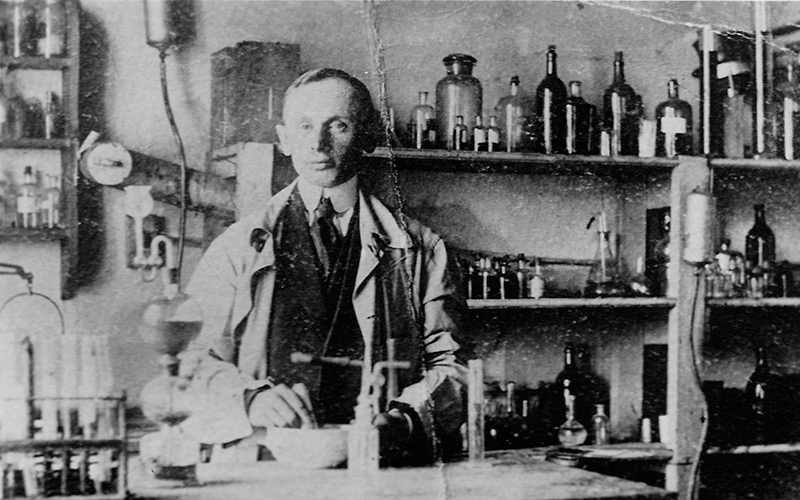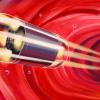In the second of our series looking at landmark moments in clinical chemistry, Stephen Clarke turns his attention to the history...

... of testing for uric acid and bilirubin. Revisiting older methodologies often helps the interested reader to trace the origin of current tests, learn about the author(s) and the challenges they faced.
From the vast literature, this short review selects two landmark papers with background notes, paying tribute to those early pioneers who developed assays for the analysis of blood serum uric acid and bilirubin.
Blood serum uric acid
While gout was recognised as a disorder of joints by the ancient physicians of Egypt, Greece and Rome, its cause was not known. Needle-shaped crystals of uric acid were identified by Scheele (1776) in urine deposits and by Wollaston (1797) in tophi and renal calculi.
Alfred B Garrod, an English physician, proposed an association of raised serum uric acid with gout in 1848 and developed a quantitative gravimetric method and later the celebrated “thread test” crystallising uric acid on a linen thread (1).
While German biochemist Ernst Salkowski devised a gravimetric method using ammoniacal silver nitrate to precipitate silver urate (1870). The heterocyclic structure was established by synthesis in 1882 and is a strong reducing agent and potent antioxidant.
New methods
Otto Folin and Willey Denis published their paper, A new (colorimetric) method for the determination of uric acid in blood, in the journal Clinical Chemistry in 1913 (2). See box above for an extract.
Folin was Professor of Biological Chemistry at Harvard Medical School from 1907 and developed a career-long interest in the measurement of uric acid, following a working visit to Salkowski’s laboratory in Berlin in 1897 (3). In 1901, Folin attempted to develop an analysis by the reduction of the hexavalent tungsten of phosphotungstic acid (PTA) by uric acid in alkaline conditions, to lower valences to form a blue chromogen.
However, applying this reaction to biological fluids proved highly problematic due to reagents of variable quality, interference by phenols and the weak and unstable colour produced. With his long-term colleague Willey Denis (4) a working method was established for serum uric acid with proteins removed by acid precipitation, the formation of silver urate, a modified PTA reagent and sodium carbonate added to improve colour intensity and stability.
The technique was laborious and required 15ml of blood, but acted as a model for future work notably with Hsien Wu (1919), Trimble (1924) and by Folin (1930). Improvements included a reduced blood sample volume, a more robust assay and developing a standard material which was stable.
Further modifications were made during the next 25 years, such as Caraway (1955) who included protein precipitation prior to PTA colorimetry. More specific methods employed uricase to catalyse the oxidation of urate to allantoin, hydrogen peroxide and carbon dioxide, using UV pectrophotometry or automated colorimetry using peroxidise to link to an oxygen acceptor, such as 4-aminophenazone, in order to generate a chromogen (5,6).
Serum bilirubin
Jaundice and its association with the liver was described in the Hippocratic corpus (c 280 BC) and recognised in the Talmud Jewish ruling (200 AD). Yellow crystals of bilirubin in the basal ganglia were identified in neonatal jaundice in 1875 (7) and the absorbance spectrum of bilirubin, along with haemoglobin derivatives, were investigated by Gamgee in 1895.
Danish internist Jens Meulengracht devised the “icteric index” in 1921 witha simple dilution of serum colour compared to a standard solution of potassium dichromate. Bilirubin is derived from the haem moiety of haemoglobin and has an open chain tetrapyrrole ring structure, which could be coupled to diazo compounds to form a chromogen.
This was utilised by Paul Ehrlich in 1883 for urine bilirubin and later applied more signifi cantly with various serum studies in 1913 and 1916 by the Dutch physician Van den Bergh in patients with obstructive jaundice (8). His diazo reagent combined 0.5% sodium nitrite and acidified sulphanilic acid to form purple azobilirubin with bilirubin.
This was used extensively with numerous procedural modifications to measure direct and indirect bilirubin fractions. To reduce possible turbidity, some early methods precipitated protein after adding the diazo reagent.
New techniques
In 1937 Helga Tait Malloy and Kenneth A Evelyn published The determination of bilirubin with the photoelectric colorimeter in The Journal of Biological Chemistry (9). See box above for an extract.
During research at the Department of Medicine, Royal Victoria Hospital, Montreal, Evelyn devised a filter photometer for use to measure bilirubin in a simple diazo procedure, which was, from personal experience, widely used for at least 30 years.
Serum is diluted with water, diazo reagent added and then methanol, insufficient to precipitate proteins but to allow full colour production, which is read at 540nm, or using a yellow-green filter, against an acid blank after 30 minutes.
A primary standard of bilirubin is used for calibration and requires careful preparation and storage. In the procedure for direct bilirubin, water is substituted for methanol. There have been numerous alternative versions of the diazo technique, notably by Jendrassik and Grof in 1938 (10) improving sensitivity by converting the pink azobilirubin to a strong blue chromogen by adding alkali and reducing the time for colour development using “accelerators”, such as caffeine, benzoate or urea in combination.
Other methods of note include that of Powell (1944) with sodium benzoate-urea while Lathe and Ruthven (1958) used a more acidic diazo reagent more suitable for paediatric studies. The characteristic absorbance spectrum of bilirubin was used in dual wavelength spectrophotometric methods introduced in the 1950s, which led to the production of commercial “bilirubinometers”, which were especially valuable in the investigation of neonatal jaundice in the laboratory or in special care baby units.
Two comprehensive reviews of the evolution of bilirubin methods have been produced by Watson (11) and Westwood (12) in 1961 and 1991, respectively. It seems quite remarkable that modern automated analysers still use based on the diazo reaction, rst described by van den Bergh a century ago.
Stephen Clarke is a retired IBMS Fellow. He previously in clinical chemistry at Southmead Hospital, Bristol. References can be found at: bit.ly_BMSrefs_Feb
INTRODUCTION EXTRACT
Folin O, Denis W. (1913) A new (colorimetric) method for the determination of uric acid in blood. J Biol Chem 13: 469-75.
“Notwithstanding the great physiological and clinical interest which for more than a hundred years has been attached to the ‘uric acid in blood’ no suitable method for the determination of this uric acid has yet been discovered.
The ammoniacal silver nitrate method of Salkowski and the cupric bisulphite method of Kruger for precipitating uric acid have indeed rendered valuable service, for by their means the presence of traces of uric acid in certain kinds of pathological blood has been positively established.
Rough quantitative determinations of the uric acid in such blood have also been made on the basis of those methods though it is very doubtful how trustworthy have been the results.”
INTRODUCTION EXTRACT
Malloy HT, Evelyn KA. (1937) The determination of bilirubin with the photoelectric colorimeter.
J Biol Chem 119: 481-90.
“The main source of error in the determination of bilirubin in serum by the diazo reaction has been the loss caused by adsorption on the protein precipitate. In addition, the lack of an accurately matching artificial standard and the sensitivity of the azobilirubin color to changes in pH have made accurate calorimetric determinations impossible, without the aid of some type of objective photometer such as the spectrophotometer, the Pulfrich photometer, or the photoelectric calorimeter. In this paper we shall describe a method for the quantitative determination of both direct and indirect bilirubin in serum, in which protein precipitation and consequent loss of bilirubin have been eliminated. By a slight modification of the method, a quantitative study of the behavior of the direct, reaction has also been made possible.”
REEFRENCES
1. Caraway WT. The scientific development of Clinical Chemistry to 1948. Clin Chem 1973; 19(4): 373-383
2. Folin O, Denis W. A new (colorimetric) method for the determination of uric acid in blood. J Biol Chem 1913; 13:469-475
3. Meites S. Otto Folin’s medical legacy. Clin Chem 1985; 31(8): 1402-1404
4. Meites S. Willey Glover Denis (1879-1929) Pioneer woman of Clinical Chemistry. Clin Chem 1985; 31(5): 774-778
5. Henry RJ, Sobel C, Kim J. A modified carbonate-phosphotungstate method for the determination of uric acid and comparison with the spectrophotometric uricase method. Am J Clin Path 1955; 28: 152-160
6. Association for Clinical Biochemistry. Urate (serum, plasma) analytical methods, 2012
7. Gartner LM Neonatal jaundice a selective retrospective Chapter 6 Historical review and recent advances in neonatal and perinatal medicine. 1980 Mead Johnson Nutritional Division
8. Van den Bergh AAH, Snapper J. Deut Arch Klin Med 1913; 110:540
9. Malloy HT, Evelyn KA. The determination of bilirubin with the photoelectric colorimeter. J Biol Chem 1937; 119: 481-490
10. Jendrassik L, Grof P. Simplified photometric determination of blood bilirubin Biochem. Zeitschr. 1938; 297: 82-89
11. Watson D. Analytic methods for bilirubin in blood plasma. Clin Chem 1961; 7(6): 603-625
12. Westwood A. The analysis of bilirubin in serum. Ann Clin Biochem 1991; 28: 119-130




